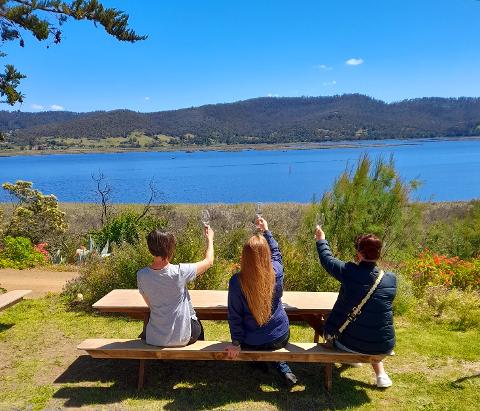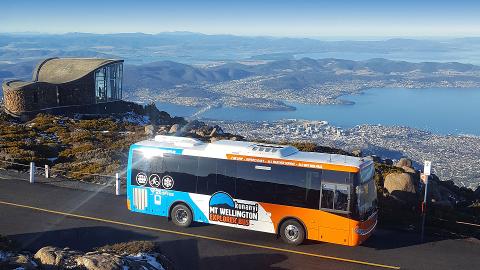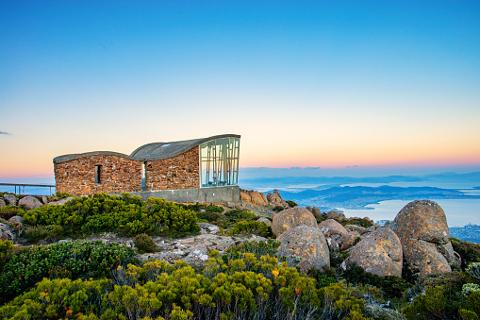Derwent Bridge sits right in the beating heart of Tasmania. Sandwiched between Lake Saint Clair and Switchyard Bay, Derwent Bridge sits right at the foot of Cradle Mountain National Park. The Lyell Highway cuts right through the town and over the Derwent River across a bridge of the same name.
It is an incredibly scenic drive passing through Derwent Bridge. The Lyell Highway splits the Wild Rivers National Park and features a few accommodation units as well as a public house. It's no wonder that the 2009 television drama The Last Confession of Alexander Pierce was filmed in this rustic and scenic town.
Centrally located on the Tasmanian island, Derwent Bridge is 147 km away from Hobart via the Lyell Highway. It's approximately the same mileage from Devonport and Launceston. It'll take you about 2.5 hours by car from each city.
This scenic town sits about 5 km south of Lake Saint Clair. The picturesque lake is the deepest in all of Australia and can be explored by chartering a boat. Lake Saint Clair is crowned by snowcapped peaks in every direction and is the southern end of the Cradle Mountain-Lake Saint Clair National Park.
 You'll also find Lake King William which features some of the best trout fishing in all of Tasmania. You won't find much in this incredibly rustic town except for a few accommodations, a roadside public house and a brand-new Visitor Information Center. The Visitor Centre attracts outdoor adventures on their way into the incredible natural beauty of the Cradle Mountain-Lake Saint Clair National Park.
You'll also find Lake King William which features some of the best trout fishing in all of Tasmania. You won't find much in this incredibly rustic town except for a few accommodations, a roadside public house and a brand-new Visitor Information Center. The Visitor Centre attracts outdoor adventures on their way into the incredible natural beauty of the Cradle Mountain-Lake Saint Clair National Park.
Derwent Bridge essentially offers a crossing over the Derwent River. Aside from a brand-new Visitor Information Centre, the town only boasts a roadside public house. The public house is quite an attraction for people venturing off into the wilderness as it is a unique place for a meal and a drink. It's where you'll find like-minded travellers that love the outdoors and aren't afraid to venture off into the great unknown.
 You'll find adventure seekers and fishermen in Derwent Bridge. Nearby Lake Saint Clair offers all sorts of nature walks. The hikes are split up into Strolls, Short Walks, half-day and full-day treks. The weather tends to change dramatically at the southern end of the national park, so the park only attracts travellers willing to put up with the elements. Essentially, you'll only find the heartiest of nature lovers hiking in Derwent Bridge.
You'll find adventure seekers and fishermen in Derwent Bridge. Nearby Lake Saint Clair offers all sorts of nature walks. The hikes are split up into Strolls, Short Walks, half-day and full-day treks. The weather tends to change dramatically at the southern end of the national park, so the park only attracts travellers willing to put up with the elements. Essentially, you'll only find the heartiest of nature lovers hiking in Derwent Bridge.
Nearby Lake King William offers fishermen some of the best trout fishing in the state. But you don't have to be an outdoor adventurer to enjoy Derwent Bridge. The Lake Saint Clair Ferry is a wonderful way to experience the lake and the mountains beyond. It takes a 28 km return trip through Narcissus Bay, Echo Point and Cynthia Bay. The 22-person boat completes the circuit in 90 minutes while dropping off backpackers in the wilderness. Image Credit: keiichihikira (Cradle Mountain) and Tourism Australia & Graham Freeman (trail)
You'll find a few lodges, chalets and studios along the Lyell Highway that cuts right through Derwent Bridge. Or you can choose to stay at the roadside public house for a more interesting accommodation.
Derwent Bridge's main attraction is Lake Saint Clair National Park. You'll find an extensive carpark with a brand-new Visitor Information Centre for this World Heritage Wilderness Area.
 There's a four-panelled information board right at the foot of the lake. It will give you a brief history of the area as well as detailed descriptions of many walks you can take through the natural surrounds. The walks are divided from short strolls to full-day hikes. It's the perfect place to make a pitstop for a walk on a drive through the heart of Tasmania. Image Credit: Redzaal (Lake Saint Clair)
There's a four-panelled information board right at the foot of the lake. It will give you a brief history of the area as well as detailed descriptions of many walks you can take through the natural surrounds. The walks are divided from short strolls to full-day hikes. It's the perfect place to make a pitstop for a walk on a drive through the heart of Tasmania. Image Credit: Redzaal (Lake Saint Clair)
The famous roadside public house will have interesting meals on offer every day. You can also head to a hotel in the heart of Derwent Bridge for a fancier meal prepared by an acclaimed chef.
The first European to come through the area was not an explorer. Convict James Goodwin escaped up the Gordon and Franklin Rivers to climb the mountains to the west of Derwent Valley. Throughout the 1800's, surveyors continually commented on the beautiful bays and golden beaches of the area. Finally, in 1887, Deputy Surveyor General Charles Sprent proclaimed "the region is well worth opening up for tourists and lovers of the picturesque."
 Locals campaigned for the area to become a national park as soon as 1920. In 1930, the first guesthouse and camp were built at Derwent Bridge. But it was not until 1971 that the area was declared a national park with 132,000 hectares set aside for preservation. In 1982, the Cradle Mountain-Lake Saint Clair National Park was placed on the World Heritage List. Image Credit: Pierre Destribats (Aurora Australis over Cradle Mountain)
Locals campaigned for the area to become a national park as soon as 1920. In 1930, the first guesthouse and camp were built at Derwent Bridge. But it was not until 1971 that the area was declared a national park with 132,000 hectares set aside for preservation. In 1982, the Cradle Mountain-Lake Saint Clair National Park was placed on the World Heritage List. Image Credit: Pierre Destribats (Aurora Australis over Cradle Mountain)
Derwent Bridge features a warm and temperate climate, but the weather can be unpredictable. Many hikers find themselves in the midst of a storm after venturing out on a beautiful morning. Plenty of rain comes through the area and can pop up rather quickly, so pack accordingly when heading out into the wilderness.
Spend a full day in Derwent Bridge by taking the ferry out on Lake Saint Clair one-way to hike through the World Heritage Wilderness back to town. It's the perfect way to experience the lake and its beautiful walks.
The Wall in the Wilderness is an ongoing art project featuring a massive wooden sculpture in Derwent Bridge. It's an easy walk to the wall and well worth it.
The trout fishing in Lake King William is some of the best in all of Australia. The lake is open all year round and overflowing with wild brown and rainbow trout.












































